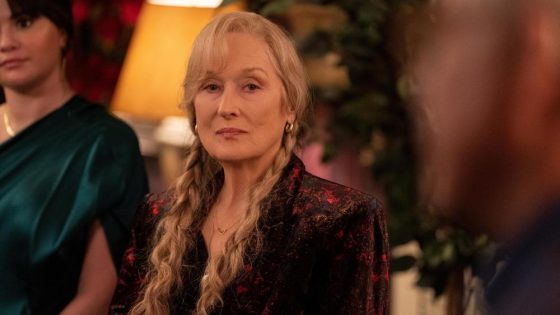Artisans working on Hulu’s “Only Murders in the Building” found inspiration in Meryl Streep’s body of work when the three-time Oscar winner joined the series as Loretta Durkin, a quirky, struggling, bohemian actor, for the show’s third season.
Oliver (Martin Short) casts Loretta in his new play, “Death Rattle,” and she could not be happier: the role gives her a chance to reconnect with her long-lost son Dickie (Jeremy Shamos), whom she gave up for adoption. She’s one step closer to him since his brother, Ben (Paul Rudd), is also in the
play. As each episode unfolds, the series reveals a new layer to Loretta and her idiosyncrasies.
For her look, Streep’s longtime hair and makeup artist, J. Roy Helland, was on hand — and knew she wanted braids and bangs. “I knew I had the wig to do it,” he says, turning to the archives of their past work and pulling the soft gray/blonde wig he had used on Streep’s Aunt Josephine in the 2004 film “A
Series of Unfortunate Events.” “It has a very tight pre-curl, which makes it very natural looking. Loretta is quite bohemian with a ‘natural’ beauty, so we do a ‘natural’ light makeup.”
Loretta’s “Death Rattle” look meant Helland could bring out stage lashes and rouge, and for the after party, brush out the wig’s braids, but leave the lashes and rouge as-is.
With her hair and makeup established, set decorator Rich Murray was tasked with helping create Loretta’s studio apartment. He was told it needed to be charming and warm. “She’s lived in that same studio apartment for 35 or 40 years,” Murray explains.
Murray looked to where Gene Kelly’s character Jerry lived in “An American in Paris” for inspiration on how to best optimize space. “Jerry Mulligan’s apartment was ideal. It has a lot of built-in quirkiness with dropdown, pull-down things,” says Murray. “Everything is so neatly finessed … and so we pulled from that.”
Loretta’s apartment was a treasure trove of nods to Streep’s career.
HULU
In Episode 5, audiences got a closer look at Loretta’s living space as she invited Oliver back to her apartment for dinner. To pay homage to Streep’s illustrious career, Murray inserted Easter eggs that nodded to her work wherever he could.
The one film Murray wanted to be sure to acknowledge was “The Devil Wears Prada,” so he “built a series of books in her bookcase, and across the book spines is the logo from the film.”
Loretta’s desk is littered with scripts from films and plays that Streep has appeared in. Murray also gave a special nod to Streep’s Oscar-winning role in “Kramer vs. Kramer.” “On her fridge door, we closely mimic the bulletin board over her son Billy Kramer’s bed in the film. And there’s a Christmas card from her character to Billy,” he says. “So, we recreated that card and hung the images around it.”
The framed tea towel hanging in the apartment is a nod to another film, “Suffragette,” in which
Streep played British political activist Emmeline Pankhurst. “It hangs between the windows. Her character’s name is on the tea towel,” he says. “‘Suffragette’ is a magazine that came out in the early 1900s and it was an activist pamphlet, so we put her name on that.”
When it came to crafting Loretta’s closet, costume designer Dana Covarrubias and showrun ner John Hoffman had the idea that the character would be a sliding door version of Streep’s life. “What if she never made it, just as millions of actors never do? They go on auditions and try to make it, and never hit it big until very late,” says Covarrubias.
With that in mind, she looked at the clothing the actor wore when she was starting her career.
“We were thinking, what if she were arrested in that time? People tend to wear clothing that was their heyday for the rest of their lives.”
Covarrubias notes Streep was wearing autumnal shades, teals, olives and dark blues, so mood boards were crafted based on that.

Once Covarrubias met with Streep over Zoom and started talking, they decided Loretta was a woman who had given up everything, including her child, to act. “The idea we had was that she would be a wallflower, wearing nondescript items.
You wouldn’t notice she’s there so she can step into any role and become any person, take on any character you want,” she says. “In the industry, we call it indie, very nondescript. She had basic pants
or tops that you could add one accessory to and turn it into something else.”
However, Covarrubias had the idea that Loretta’s other closet contained “pieces she’s stolen throughout the years from different characters she’s played in Off Broadway productions.” And shopping for Loretta was easy, as Covarrubias sought out brands that looked vintage, including classic Polo Ralph Lauren and Free People “because it was flowy and soft.”

Loretta’s closet was autumnal shades, teals, olives and dark blues.
HULU
Covarrubias loved that Loretta lived in Greenwich Village and had been there since the 1960s. “She’s a bit like Patti Smith and in that world. I wanted to make sure she blended well with the other characters, but also made sure she was individual and bohemian,” she says.
Covarrubias worked hard to create differences between Loretta’s bohemian style and Oliver’s style, as befitting the characters, while also making sure the color palettes worked well together.
“Oliver is very bohemian in his way. But he’s fancy bohemian. She lives in her tiny little apartment in the Village. Oliver was a very famous theater director, and he had money at one point, and she’s never really gotten to that point.”
Source Agencies



